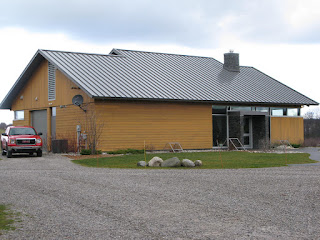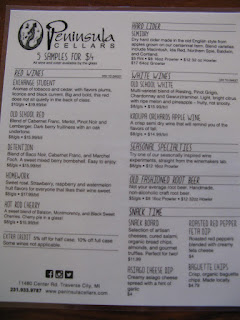Hi again, everybody, and
welcome back to Cépage et Cuisine, Mary’s and
Brian’s blog about wine, food, places, and culture. This is our second of two
installments about our trip to northern Michigan to explore the wine country.
Today we explored the Leelanau Peninsula from our base of operations in Suttons
Bay, a charming small town on the eastern shore of the peninsula facing Grand
Traverse Bay.
Our hosts were Jim and
Linda at Korner Kottage, a 1920s-era house on the main street of town.
They are friendly folks who share a generous hospitality.
Here are views of the
living room and dining room.
The orange and white
marker poles are placed in anticipation of winter so the snowplows and shovelers
know where the sidewalks and fire hydrants are located. You can see more of these in the photo of the cottage above.
Here's a look at the main street of Suttons Bay.
Our first stop of the day
was at Silver Leaf Vineyard and Winery. The property was acquired recently by a
new owner who is still getting established and learning about viticulture and
enology. He was very friendly and helped us learn about some of the challenges
of the wine industry in northern Michigan. They’ve had a couple of very hard
winters recently that damaged many of the vines, requiring severe pruning or
even replanting. For some varieties, including Pinot Noir, some producers haven’t
been able to make wine and have bought fruit from Oregon growers. We aren’t
interested in traveling to northern Michigan to taste wine from grapes grown in
Oregon, but I certainly understand that they have to have wine to sell in order
to stay in business.
Our next stop was
Blustone Vineyards.
They have a beautiful new tasting and production facility
on a windswept hilltop near Suttons Bay.
Mary and I both like the fact that the peninsula
is still a very diverse agricultural ecosystem. In these photos you can see
vineyards alternating with cherry trees. We also saw lots of apple orchards,
pumpkins, and vegetable farms.
Like Silver Leaf,
Blustone’s vineyards have suffered in the winters of 2014 and 2015, requiring
replanting. The vineyards on the downhill side of the prevailing winds from
Lake Michigan survived, but they have had to buy Oregon fruit, too. They did
have estate fruit for their Chardonnay and Riesling, which we thought seemed a
bit thin and overcropped. We did enjoy some of their hard apple cider, which is
offered by many of the wineries, and bought some to take home. We were told
that this year’s vineyard crop is excellent and the producers are looking forward to
very nice wine in the coming year or two as the wines come to bottle.
The Leelanau Peninsula
straddles the 45th parallel. Here’s a sign on the highway that marks
the exact spot. It’s interesting that this is halfway from the North Pole to
the equator. I think of this part of the country as pretty far north and the
equator as way down there, but the map doesn’t lie.
And from about the same
spot and across the highway, here’s a view of the beautiful shoreline of Grand Traverse Bay just north
of Suttons Bay.
After lunch at the
Village Inn in Suttons Bay, the next producer we visited was 45 North Vineyard
and Winery, so named because of the latitude. When we pulled into the gravel
lot of the tasting room we saw a stretch limo and a winery touring company SUV.
We’ve learned from experience that this is not a good sign, both for the
people we will encounter in the tasting facility and for the producer. We’re
not wine snobs, I promise, but we enjoy a leisurely visit in a beautiful place,
chatting with the staff and the winemakers about wine, grape growing, and
culture. For us, the focus is the wine and the place, not the drinking.
Sure enough, the place
had the feel of a rolling party in a room that had more of a bar and retail
shop feel than a serious wine producer. They even had a full kitchen with a
menu of light fare. There’s nothing wrong with having fun, of course, but they
seem to cater to visitors who are probably not all that serious about viticulture
and enology. The business model may not be adequately supported at this point
by people like us. There was another couple about our age next to us at the bar
(see, it’s a bar, not really a counter) who commented that the Chardonnay is
good for deglazing the pan when cooking. We thought the wines were unremarkable
and didn’t stay long.
L. Mawby, north of
Traverse City, is one of the most established producers on the peninsula and
makes only sparkling wines, which has helped Larry Mawby establish a market
niche and a good return on the specialized equipment required to produce
sparkling wine in méthode Champenoise,
the method used in Champagne.
We enjoyed the wines and brought home two bottles
of the Brut blanc de blancs, white of
whites, 100% Chardonnay and 100% estate or peninsula grown. Without a doubt,
this was the wine we tasted on our visit that can compete with sparkling wines
of the world. It may not quite have the depth and complexity of the finest
Champagnes, but it is certainly as good as many Champagnes and as good as most
of the crémant wines of Burgundy,
Jura, and the Loire of France and superior to most Prosecco and Cava. At $23,
it is an excellent value.
The final visit of the
day was Brengman Brothers, also near Traverse City. They reduce their burden on
the electrical grid through extensive solar power production.
We got the impression of
a producer that is serious about growing and making good wine. We also had a
great visit with the young staff person who turned out to be the assistant
winemaker, vineyard worker, and weekend tasting room staffer, sort of a jack of
all trades and what we really enjoy when we’re visiting small producers. We
were able to have a thoughtful conversation about the grapes they grow, where
they’re grown on the property, the challenges they face, the goals for their
wine. All of their grapes are estate grown. Like many of the other producers on
the peninsula, they do better with white varieties than red and not necessarily
all of the whites. We did admire the dry Gewurztraminer and brought some home.
The picture we formed of the wine in northern Michigan is that it is hit and miss for now, and
probably more miss than hit. For sure, there are some noteworthy examples of
good and excellent wines. I think they are a region that is learning and
growing. They remind me in some ways of the Finger Lakes of upstate New York, which we visited two years ago. Both
regions face the challenges of a winter climate that can be severe and create
risk in the vineyards. Both regions must balance the cost of investment with
the likely gains in their markets. Both regions have more strength in white
wines than red wines. A decision I imagine the Michigan producers are facing is whether they want
to compete on the world stage with the West Coast and Europe, which will
require significant investment, limiting crop yields to produce wines of more
density, complexity, and interest, and acquiring necessary technology. If yes,
they will have to charge a higher price for their wines. Whether there is a
market to make the business model viable may be unknown. My guess as an
interested consumer is they can grow the market at the same time they evolve
the quality of the wines. The alternative is to continue to produce serviceable
wines at low cost for a mostly regional base of consumers, which is fine if
that becomes the long-term strategy.
The cuisine is another
story. We had dinner at 9 Bean Rows, a locavore, farm-to-table restaurant in an old firehouse in
Suttons Bay. They recently changed chefs and have been regaining their footing,
but we were both very impressed with the quality and creativity of their work.
Another indication is that Mario Batali was having dinner at the next table!
Sorry we don’t have a photo of Mario, instead choosing to let him enjoy his dinner
in peace. He looked like he just came off the Food Network set, orange clogs,
knee-length shorts and all. He apparently owns a second home nearby and was
visiting for the holiday weekend.
Our first course was a
shared Raclette with potatoes and chorizo, which was delicious. It was served in a cast iron dish, which is ideal.
Mary had a main course of
pork meatballs with house-made pappardelle pasta in a marinara sauce, which
practically brought her to tears of joy. Sorry about the grainy photos, but it
was dark in there and we didn’t want to use the flash.
I had a braised beef gulyas, which is apparently the same as
goulash. It was served in a bowl with a rich stock braising liquid, roasted
fingerling potatoes that had a wonderful outer skin crust, peppers and onion, and a delightful little hit of
crème frâiche. It
was spectacular.
Here’s the wine, a 2012
Morgon by Domaine des Gaudets. It is a Gamay from a village in the Beaujolais
region of France. For our most faithful readers (thanks to both of you), you
might recall Mary and I visited Beaujolais on a previous France trip and
blogged about it. The wine was delicious, fresh, earthy, fruity of berries and
perhaps plum notes, and elegant in its compatibility with both dishes.
The wine
list at 9 Bean Rows was modest and limited by the size of the small restaurant,
but there was very little local wine. The same was true the previous evening at
Martha’s Leelanau Table. I think this is probably an indication of the level of
casual and fine dining in relation to the local wine scene.
On the whole, we had a
really nice trip and would like to return. We’d like to visit more wine
producers, see how the wines evolve, and experience more of the cuisine. Plus,
it’s such a pretty and peaceful place. Linda and Jim, we’ll be in touch.
That’s our post for
today. Thanks for reading us at Cépage et Cuisine.
We hope you enjoyed it. We welcome your comments, questions, and suggestions.
We’ll post from time to time as we grow in our learning and experience about
wine, food, people, and places. In the meantime,
Cheers!
Mary♥Brian




















































